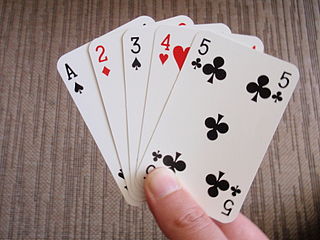
A playing card is a piece of specially prepared card stock, heavy paper, thin cardboard, plastic-coated paper, cotton-paper blend, or thin plastic that is marked with distinguishing motifs. Often the front (face) and back of each card has a finish to make handling easier. They are most commonly used for playing card games, and are also used in magic tricks, cardistry, card throwing, and card houses; cards may also be collected. Some patterns of Tarot playing card are also used for divination, although bespoke cards for this use are more common. Playing cards are typically palm-sized for convenient handling, and usually are sold together in a set as a deck of cards or pack of cards.

The tarot is a pack of playing cards, used from the mid-15th century in various parts of Europe to play games such as Italian tarocchini, French tarot and Austrian Königrufen, many of which are still played today. In the late 18th century, some tarot decks began to be used for divination via tarot card reading and cartomancy leading to custom decks developed for such occult purposes.

Karuta are Japanese playing cards. Playing cards were introduced to Japan by Portuguese traders during the mid-16th century. These early decks were used for trick-taking games. The earliest indigenous karuta was invented in the town of Miike in Chikugo Province at around the end of the 16th century. The Miike Karuta Memorial Hall located in Ōmuta, Fukuoka, is the only municipal museum in Japan dedicated specifically to the history of karuta.

In playing cards, a suit is one of the categories into which the cards of a deck are divided. Most often, each card bears one of several pips (symbols) showing to which suit it belongs; the suit may alternatively or additionally be indicated by the color printed on the card. The rank for each card is determined by the number of pips on it, except on face cards. Ranking indicates which cards within a suit are better, higher or more valuable than others, whereas there is no order between the suits unless defined in the rules of a specific card game. In a single deck, there is exactly one card of any given rank in any given suit. A deck may include special cards that belong to no suit, often called jokers.

The king is a playing card with a picture of a king displayed on it. The king is usually the highest-ranking face card. In the French version of playing cards and tarot decks, the king immediately overtakes the queen. In Italian and Spanish playing cards, the king immediately outranks the knight. In German and Swiss playing cards, the king immediately outranks the Ober. In some games, the king is the highest-ranked card; in others, the ace is higher. Aces began outranking kings around 1500 with Trappola being the earliest known game in which the aces were highest in all four suits. In the Ace-Ten family of games such as pinochle and schnapsen, both the ace and the 10 rank higher than the king.

A jack or knave is a playing card which, in traditional French and English decks, pictures a man in the traditional or historic aristocratic or courtier dress, generally associated with Europe of the 16th or 17th century. The usual rank of a jack, within its suit, plays as if it were an 11. As the lowest face card, the jack often represents a minimum standard — for example, many poker games require a minimum hand of a pair of jacks in order to continue play.

In a deck of playing cards, the term face card (US) or court card (British) is generally used to describe a card that depicts a person as opposed to the pip cards. They are also known as picture cards, or until the early 20th century, coat cards.
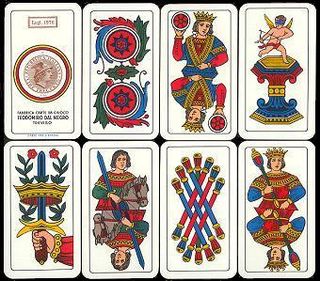
Scopa is an Italian card game, and one of the two major national card games in Italy, the other being Briscola. It is also popular in Argentina and Brazil, brought in by Italian immigrants, mostly in the Scopa di Quindici variation. Scopa is also played in former Italian colonies such as Libya and Somalia or some other countries like Tunisia with changed appearance in the cards. It is played with a standard Italian 40-card deck, mostly between two players or four in two partnerships, but it can also be played by 3 or 6 players.
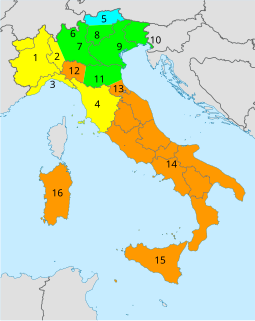
Playing cards have been in Italy since the late 14th century. Until the late 19th century, Italy was composed of many smaller independent states or under foreign occupation which led to the development of various regional patterns of playing cards; "Italian suited cards" normally only refer to cards originating from northeastern Italy around the former Republic of Venice, which are largely confined to northern Italy, parts of Switzerland, Dalmatia and southern Montenegro. Other parts of Italy traditionally use traditional local variants of Spanish suits, French suits or German suits.

Spades form one of the four suits of playing cards in the standard French deck. It is a black heart turned upside down with a stalk at its base and symbolises the pike or halberd, two medieval weapons.
Minchiate is an early 16th-century card game, originating in Florence, Italy. It is no longer widely played. Minchiate can also refer to the special deck of 97 playing cards used in the game. The deck is closely related to the tarot cards, but contains an expanded suit of trumps. The game was similar to but more complex than tarocchi. The minchiate represents a Florentine variant on the original game.
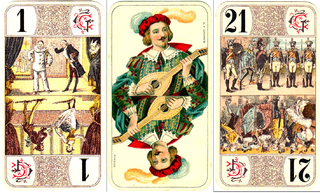
The Tarot Nouveau, French Tarot Nouveau or Bourgeois Tarot deck is a pattern of tarot cards. As such it differs from those tarot decks used in fortune-telling, such as the Tarot of Marseilles and Rider-Waite decks, in that the Tarot Nouveau is designed solely for playing the various tarot card games for which the 78-card tarot deck was originally devised. In the French language, this deck is often called the tarot à jouer or playing tarot. This usage is distinct from cartomancy and other divinatory purposes, for which the tarot is most commonly known outside Continental Europe. This deck is most commonly found in France, Wallonia, Romandy, and Québec for French Tarot; and Denmark for Danish Tarok.
A knight or cavalier is a playing card with a picture of a man riding a horse on it. It is a face card and is called caballo in Spanish playing cards and cavallo in Italian playing cards. In these decks, it ranks between the knave and the king within its suit. Among French playing cards, the knight (chevalier) can only be found in tarot decks. In Latin and French suited tarot decks, the knight ranks between the knave and the queen.
The Tarocco Piemontese is a type of tarot deck of Italian origin. It is the most common tarot playing set in Italy, much more common than the Tarocco Bolognese or the Tarocco Siciliano. The most popular Piedmontese tarot games are Scarto, Mitigati, Chiamare il Re, and Partita which are played in Pinerolo and Turin. This deck is considered part of Piedmontese culture and appeared in the 2006 Winter Olympics closing ceremony held in Turin. As this was the standard tarot pack of the Kingdom of Sardinia, it was also formerly used in Savoy and Nice before their annexation by France. It is also used as an alternative to the Tarocco Siciliano in Calatafimi-Segesta, Sicily. Outside of Italy, it is used by a small number of players in Ticino, Switzerland and was used by Italian Argentines.

German playing cards are a style of playing cards used in many parts of Central Europe characterised by 32- or 36-card packs with the suits of Acorns (Eichel), Leaves, Hearts and Bells.
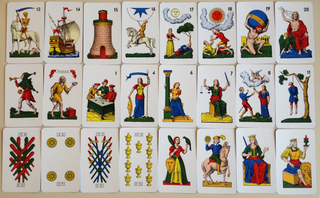
The Tarocco Siciliano is a tarot deck found in Sicily and is used to play Sicilian tarocchi. It is one of the three traditional Latin-suited tarot decks still used for games in Italy, the others being the more prevalent Tarocco Piemontese and the Tarocco Bolognese. The deck was heavily influenced by the Tarocco Bolognese and the Minchiate. It is also the only surviving tarot deck to use the Portuguese variation of the Latin suits of cups, coins, swords, and clubs which died out in the late 19th and early 20th centuries.

The Tarocco Bolognese is a tarot deck found in Bologna and is used to play tarocchini. It is a 62 card Italian suited deck which influenced the development of the Tarocco Siciliano and the obsolete Minchiate deck.

French playing cards or French-suited playing cards are cards that use the French suits of trèfles, carreaux, cœurs, and piques. Each suit contains three face cards; the valet, the dame, and the roi (king). Aside from these aspects, decks can include a wide variety of regional and national patterns which often have different deck sizes. In comparison to Spanish, Italian, German, and Swiss playing cards, French cards are the most widespread due to the geopolitical, commercial, and cultural influence of France, the United Kingdom, and the United States in the past two centuries. Other reasons for their popularity were the simplicity of the suit insignia, which simplifies mass production, and the popularity of whist and contract bridge. The English pattern of French-suited cards is so widespread that it is often also known as the International or Anglo-American pattern.

Aluette or Vache ("Cow") is an old, plain trick-taking card game that is played on the west coast of France. It is played by two teams, usually of four people, but sometimes also of six. It is unusual in using a unique pack of 48 Spanish playing cards and a system of signalling between playing partners. The French colloquial names for the game, jeu de la Vache or Vache, refer to the cow depicted on one of the cards.



































